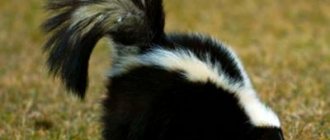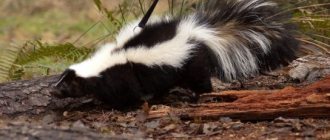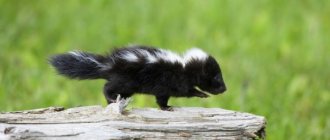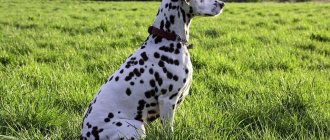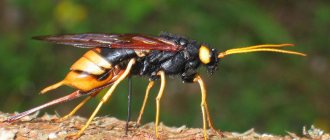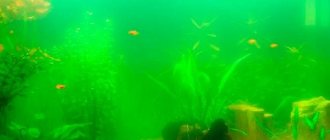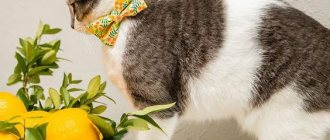- Skunk Smell
Which animal is the most feared by the rest of the animal kingdom? No, not a lion, not
a bear, not a tiger, and not any other even the most ferocious and formidable predator, but our today's hero - a skunk. Even very hungry predators avoid it, due, of course, to the famous skunk smell, so unbearable that it scares away almost everyone.
Description, structure, characteristics
The skunk belongs to the mammals of the order of carnivores, and until recently zoologists classified it as a member of the mustelidae family, but have now reconsidered their opinion. Skunks are now believed to form their own family, the skunk family.
You can easily recognize a skunk by its “signature” coloring, which consists of white stripes and/or spots on a black background. Skunks have a very strong build, a bushy tail and short legs with sharp claws, excellent for digging.
Skunks have poor eyesight, but this deficiency is more than compensated by their excellent sense of smell and hearing.
The largest of the skunk family, pig-nosed skunks, weigh up to 4.5 kg, the smallest, spotted skunks, weigh no more than 1 kg.
In general, the appearance of the skunk is very attractive, some people even domesticate skunks after first solving the problem with their smell; we will write about this in more detail below.
Hog-nosed skunks are the largest in the family.
Hog-nosed skunks are typically brown and white in color. They have a well-developed snout, which allows them to dig out insects and spiders from dry soil. Hog-nosed skunks are more mobile than other species. They regularly climb rocky slopes and enter caves filled with bats, their favorite delicacies.
Photo: www.animals.sandiegozoo.org
Smell
The more than unpleasant smell of these animals is perhaps their main characteristic feature. The source of the unpleasant odor of a skunk is special odorous anal glands that secrete a caustic substance that actually has such a specific aroma. Moreover, a scented stream of secretion can be sprayed by a skunk at a distance of 1-6 m.
In fact, the smell serves the skunk as an unusual defense against predators, and also a very effective defense. When in danger, skunks do not try to hide from their enemies, but instead raise their fluffy tail and stomp their paws on the ground threateningly. If the warning fails, then the skunk turns its back and shoots its foul-smelling, oily liquid at the enemy. To describe what the smell of a skunk is like, perhaps there are not enough verbal epithets. As a result, many predators, knowing about such a specific method of protecting the skunk, prefer not to mess with it at all and stay away from it.
An interesting fact: the smell of skunk secretion is so persistent that if it gets on, for example, human clothing, it is better to burn it immediately, since all means to clean the clothes after this can only mask the unpleasant odor, but will not remove it completely.
How to Get Rid of Skunk Smell
The secretion secreted by skunks not only smells pungent and “killer”, but is also a very persistent substance if it gets on clothes. In terms of its color, the substance is completely invisible, but in terms of its smell... We have already figured out what a skunk smells like. Now imagine such a “scent” on your clothes. It is almost impossible to get it out.
Traditionally, tomatoes were thought to be good for removing skunk scent. Yes, it was tomatoes that were often used by Americans to wash things that were exposed to the jet. However, after several washes, if the item was still wearable, it acquired a persistent tomato smell. Some claim the smell was that of rotten tomatoes, which is even “better.”
Thanks to the modern industry producing household chemicals and laundry detergents, removing odors from clothes has become much simpler and easier. You can use chlorine bleach, which not only corrodes the secretions well, but also removes the pungent odor from clothes. But there will be some problems with rinsing. As you know, many people will also consider the smell of bleach unpleasant and will not choose this method.
Another option is hydrogen peroxide. Experts call this method optimal. And traces of discharge are quickly removed from the fabric, and the smell disappears completely. The advantage of hydrogen peroxide is that it does not have a pungent odor like chlorine, and is also easy to rinse.
I must say that skunks are very beautiful, fluffy and good-natured animals. It's definitely worth going to the zoo or traveling to America to admire them. But remember that it is better to observe the “fragrant” beauty from afar.
Nutrition
Skunks themselves are omnivorous predators and, as a result, their main food is various small rodents,
frogs, lizards. They do not disdain carrion, and since they are omnivorous animals, in addition to meat they can feast on grass, leaves, various fruits, and nuts.
Skunks often go out hunting at night, and to successfully overtake prey they use their well-developed senses of smell and hearing. They ambush small rodents, waiting for them, and when they appear, they make a swift jump, grabbing the prey with their paws and teeth.
Skunks also love honey very much, and when they come across
bee hive, then they will certainly ruin it. Bee stings are not scary for them due to their thick fur, through which a bee sting is not able to penetrate.
Skunks are crepuscular animals
They are most active at dusk and dawn and sleep in nests or burrows during the day. Skunks spend most of their time hunting for prey.
Skunks are omnivores. They have large, sharp teeth and extremely long, curved claws. Their diet is primarily insectivorous during the spring and summer seasons, when grasshoppers, beetles, crickets, bees and other arthropods are abundant, and they switch to a carnivorous diet in the colder months. Throughout the winter they eat small mammals, chicks, eggs, amphibians, reptiles and fish.
Photo: www.animals.sandiegozoo.org
Lifestyle
Skunks live in small families or alone, and their lifestyle is largely determined by natural rhythms. Skunks do not hibernate for the winter like bears, but, nevertheless, they spend the winter in their burrows, which they either dig themselves or capture from other animals. Also, during the summer and autumn, they try to accumulate as large reserves of subcutaneous fat as possible for the winter, with which it is much easier to get through the winter cold. With the onset of spring, skunks come out of their holes and become more active.
Skunks are solitary animals
They make regular rounds of their territory, which is usually about 2.5 square meters. km. However, skunks are not territorial and are not aggressive towards their fellows, with the exception of small skirmishes over food or a den. These encounters rarely result in actual confrontation and almost never involve spraying except during mating.
One skunk can have up to ten burrows, distributed throughout its range. He uses his most secret and well-protected lair in winter. Skunks do not hibernate, but in areas where temperatures drop below freezing in the winter, they enter a state of torpor, light sleep with a decreased metabolism and slightly lower body temperature.
Enemies in nature
Thanks to such an amazing “aromatic” defense, the skunk has practically no enemies in natural conditions; it happens that they can be attacked by young predators:
foxes, coyotes, cougars, but solely due to inexperience, being still unfamiliar with “skunk scents”. Some birds of prey can also hunt skunks, such as the great eagle owl, which lives in the United States, but only because of its weak sense of smell, the eagle owl simply does not perceive the protective smell of a skunk or perceives it, but not as strongly as other animals.
What do skunks smell like?
Many people who have never encountered these animals, but only heard about their abilities, always want to know what the smell of a skunk resembles. For each person, it should be noted, the answer will be completely different. Basically, of course, the answer will be sulfur. Hydrogen sulfide, which is part of the secretion compounds, gives a distinct odor that cannot be confused with anything else.
But there are other answers to the question of what a skunk smells like. Some compare the smell of this animal's secretions to the smell of a rotten egg (again, hydrogen sulfide, but in a common form). Some say that skunk "incense" resembles the smell of burnt rubber or rotten garlic. There are even those who say that skunk smells like decaying flesh and spoiled meat.
There are a lot of possible associations associated with the smell of a skunk. And if you ask people living in America, who quite often come into contact with these animals, about what the smell of a skunk is, whether there are analogues in other animals or not, they will probably answer unequivocally: no. There are many animals in nature that have an unpleasant odor - bedbugs, beetles, birds. But there are no analogues; no one else has such an unpleasant, pungent and vile smell as a skunk.
Types, photos and names
striped skunk
The most common representative of the skunk family. It lives in North America from Canada to Mexico, often settling in forests.
Mexican skunk
The Mexican skunk is a close relative of the striped skunk, and it looks similar to it, except for the presence of softer and longer hair. It also has long hair on its head, which is why it is also called the hooded skunk. It lives in Mexico and some southern US states: Arizona, Texas.
Eastern spotted skunk
The smallest representative of the skunk family. Although, despite its small size, this skunk is not inferior to its larger counterparts in its ability to release foul odors. Also characteristic of it is its color - its fur is covered with white torn stripes, creating the illusion of spotting (hence the name of the species). Lives in both Americas.
South American skunk
The South American skunk lives in many countries in South America: Peru, Bolivia, Paraguay, Argentina, Chile. Its appearance and habits are in many ways similar to the striped skunk.
stinky badger
At first, scientific zoologists classified the stinking badger as a member of the mustelidae family, but later, thanks to the odorous properties of these animals, they were included in the kingdom of skunks. Unlike its stinky counterparts living in the New World, the stinking badger lives on the islands of Indonesia. In appearance they are similar to ordinary badgers, but in their habits and method of protection from predators they are the spitting image of a skunk.
Peculiarities of behavior and lifestyle of eared seals
Eared seals are social animals. They live in groups and form large aggregations during the breeding season.
During peak reproductive activity, fur seal rookeries on the Pribilof Islands are the largest aggregations of marine mammals in the world.
Huge concentration of fur seals
Male eared seals are polygamous: they gather around themselves harems of many females, however, just like many other marine mammals.
Since seals have limited mobility on land, they look for special places isolated from predators. Such areas are rare, and their area is limited - all this forces females to gather in large aggregations. Males are aggressive towards each other, so they try to keep their distance from competitors. The tendency of females to stick together and males to disperse leads to some males being left alone as the space next to the females is occupied by more fortunate fellows.
Extreme activity reigns at the reproductive rookery of eared seals. You can constantly hear loud barks and grunts with which its inhabitants express their emotions. Adult males make at least four types of sounds: high-pitched squeals and barks during fights over territory, growls and grunts when interacting with females, and noisy exhalations after fights. Females call their cubs and growl, threatening other females. The cubs respond to their mothers' calls and also cry when they are hungry or looking for their mother. Males periodically patrol their territory. A meeting with a neighbor usually ends in mutual threats, and sometimes fights occur, especially when a male that has recently emerged from the water invades the territory and is trying to reclaim a section of the beach. Although the well-developed neck and shoulders are protected by a thick layer of fat, serious injuries are still possible, and males sometimes die from their wounds. In addition, during a fight, opponents can trample many puppies.
Seals have a yearly cycle. During the winter, from May to October, adults remain at sea, and little is known about this part of their lives. At the end of October, sexually mature males begin to come ashore and seize territories. At this time there is a lot of space on the beach and almost no clashes occur. Later, when the beaches are filled with animals, boundaries are violated and fights become more frequent. The first females, pregnant since last season, appear on the shore after 2-3 weeks, and within a few days childbirth occurs. Over the next week, the mothers nurse the young. At this time, males are especially active, bullying neighbors and trying to collect as many females as possible on their site. Although they cannot actively collect females, they do their best to prevent them from leaving the territory. Intercepting all females attempting to leave the area results in the male coming into contact with all females in rutting state.
Pregnancy in eared seals lasts 11-12 months, including a 3-4 month delay in egg development before implantation. An exception is the Australian sea lion, in which pregnancy lasts 18 months, including a 5-6 month delay in implantation.
The duration of milk feeding varies significantly among different species of eared seals. For example, female sea lions feed their cubs milk for 5-7 months, and northern fur seals - 4 months. In many species, females can feed their young until the next breeding season or arrival in feeding areas.
The lifespan of eared seals in nature is on average 20 years.
Reproduction
Skunks are polygamous animals; one male, as a rule, has sexual intercourse with several females, thus creating a small animal harem. The mating season for skunks begins in early spring, and by mid-summer, after a short pregnancy, females give birth to cubs. Usually, on average, one skunk mother gives birth to 6 to 10 babies. Little skunks, like kittens, are born blind and only after a week their eyes begin to open. At first they are completely helpless and are completely dependent on their mother, who feeds them milk. Then the babies begin to quickly grow and get stronger, and by four months they already pose a serious “odorous” danger to others.
Skunk is a peaceful creature
However, you should not think that as soon as you approach the skunk, it will spray you with a poisonous stream. These animals are quite peaceful, only in case of danger they will resort to extreme measures. Before the poisonous “flash”, the skunk raises its tail and stomps its feet. You will definitely have time to escape; the main thing is to monitor the behavior of the animal.
A skunk's foul-smelling fluid is found in glands located under its tail. There are two of them. In case of danger, the skunk can use one stream, or it can release five or six “ammunition” at the offender at once. In this case, the jet can reach a distance of up to three meters.
Keeping at home
Recently, among lovers of strange pets, there has been a fashion for keeping pet skunks. And why not, because in appearance they are quite pleasant and cute animals. But what about the smell? A solution has been found: domestic skunks simply have their anal glands that emit their “signature” odor removed, and the skunk becomes completely harmless in this regard.
Regarding the care and nutrition of the domestic skunk, it is in many ways similar to those of dogs. That is, skunks can be fed the same food that you feed your pet dog.
Skunks are polygamous animals
The breeding season begins in mid-February and ends in mid-April. The male and female may have multiple partners over the course of several days or weeks.
If a female becomes pregnant early in the season, the development of fertilized eggs may be delayed for several weeks. Delayed implantation, lasting up to 19 days, ensures that young will be born in warmer months when food is more plentiful.
The gestation period lasts from 59 to 77 days. The female gives birth to 2 to 8 cubs. Newborn skunks are naked and blind, although their skin already has a slightly visible striped pattern. They are able to spray at about 3-4 weeks - right around the time their eyes open.
Photo: www.animals.sandiegozoo.org
The female will begin to leave the den when the cubs are 6 weeks old. They follow her in single file and tend to maintain skin-to-skin contact with each other. The hatchlings make a lot of squeaking and gurgling noises to communicate, and it may seem like one big furry animal is moving. The young begin to hunt on their own after about 2 months.
Video
And in conclusion, an interesting video about a man meeting with a real, smelly skunk.
Author: Pavel Chaika, editor-in-chief of Poznavaika magazine
When writing the article, I tried to make it as interesting, useful and high-quality as possible. I would be grateful for any feedback and constructive criticism in the form of comments on the article. You can also write your wish/question/suggestion to my email [email protected] or Facebook, with respect, the author.
Author page
This article is available in English -
Skunks.
Where does the skunk live?
As a habitat, skunks prefer flat terrain, next to which water sources are located. Southern Canada is considered to be the homeland of this animal. It cannot be found in Alaska. Most often, high populations of skunks remain in Mexico, Argentina, Costa Rica, Paraguay, Peru, Bolivia, Chile and El Salvador.
It is common for them to climb to heights of up to 1800 meters above the sea. Animals can also be found at altitudes of up to 4000 meters. Most often they live in forests and meadows. Found near cities. Their favorite habitats are bushes, slopes and edges near ponds and rivers.
The danger of caustic secretions
The secretion secreted by skunks is a rather caustic and hazardous substance to health. What does a skunk smell like? In most cases, it is compared to the smell of sulfur, since the animal's secretion consists of organic sulfur compounds. Ethanethiol and butyl mercaptan are its main components. These substances not only smell very unpleasant, but are also toxic. Their influence can easily make your head spin. People who are overly sensitive to pungent odors may even faint. Substances in the secretion act like tear gas. They may also cause nausea, vomiting and watery eyes.
Top questions about skunk spray
What is “skunk spray”?
So, skunk spray is what everyone who is faced with the problem of living next to these animals is afraid of. The substance is far from being a “superweapon”; on the contrary, it is a special secret that is produced by the skunk’s protective glands and which is very valuable for the animal. Otherwise it is called “musk”. It takes a lot of energy to produce it and subsequently it takes up to 10 days to completely replenish the “reserves” of musk. One “charge” of such liquid is enough for 5-6 defensive shots (with a range of up to 6 meters).
How dangerous is this spray for people and animals?
The bad news is that this does not apply to mucous membranes, so be careful not to get musk in your eyes. Otherwise, this oily liquid will certainly cause a burning sensation and, possibly, even temporary loss of vision for 10-15 minutes. So soiled clothes and stinking dog fur are not the worst case scenario. Just in case, we warn you: if you notice that the skunk has begun to raise its tail and wave it warningly, walk away slowly and carefully.
Is it possible to get rid of skunk smell using improvised means?
This smell is very persistent: it can be masked for a while (for example, with vinegar or kerosene), but soon the pungent smell will return again. It is quite difficult to completely remove this stench if you don’t know how to do it correctly. This is especially true when removing odor from pet fur - without the right products, this process can take months! There are many rumors about folk remedies that eliminate this smell, but we don’t believe rumors and prefer to find out the opinions of scientists.
Thus, veterinarians from the States are debunking the myth about the effectiveness of such a popular odor eliminator as tomato juice
. Although many people believe that this method can be effective, this is not true. Tomato juice is very acidic, not very effective, and besides, it can stain the light fur of animals.
According to experts, the best traditional methods include hydrogen peroxide, lemon juice and dishwashing detergent.
. But it is absolutely certain that it will take many applications to completely remove the smell. Moreover, scientists agree that while commercial products are more expensive than home remedies, they are often more successful at removing odor on the first try. Therefore, we will dwell in more detail on finished products.
Appearance
The striped skunk is a small animal, about the size of a cat. Body length 33–46 cm, tail 18–25 cm, weight of an adult striped skunk on average 3–3.5 kg (up to 6.8 kg). Males are slightly larger than females. Skunks have a triangular face with small round ears and small black shiny eyes. There is a white arrow on the black muzzle, and wide white or yellowish stripes on both sides of the body. The coloring of individuals is individual. The bright, contrasting color warns predators: it’s better not to touch the skunk!
The front paws have 5 long curved claws used for digging. The claws on the hind legs (also 5) are shorter and straighter.
Darwin was against it
Unfortunately, many highly respected naturalists and writers have been able to instill in their readers, who have never seen a skunk in their lives, a sharply negative opinion about these animals.
Even the great Charles Darwin spoke extremely disapprovingly of them. Here is what he writes in his book “The Voyage of the Beagle”: “We also saw a couple of zorillos, or skunks, these disgusting animals are quite common here. In appearance, the zorillo is similar to a ferret, only a little larger and much thicker... Conscious of his strength, he wanders in the open field during the day and is not afraid of either dogs or people. If you set a dog on him, he instantly cools her ardor with a few drops of a stinking oily liquid, which hits the nose and causes severe nausea. Whatever the liquid gets on, the thing is ruined once and for all... This smell can be heard at a distance of a league; More than once, when entering the harbor of Montevideo, we smelled this smell on board the Beagle when the wind blew from the shore. It is reliably known that all animals give way to the Zorillo with the greatest readiness.”
The main thing is the tail
In fact, the skunk is not that scary. On the contrary, he is quite a cute animal. The size of a medium-sized cat, weighing up to 2-3 kilograms, the skunk is covered with harsh, but very thick and lush hair. The striped skunk, encountered by Darwin in Argentina, and its African cousin named Zorilla, have sharply distinguished wide white stripes that begin on the head and extend on both sides of the ridge to the tail. The animal's tail is large (up to half a meter) and surprisingly lush, like a fan, covered with mixed black and white hair and almost always lifted up triumphantly.
Striped skunks inhabit the American continent starting from southern Canada. They can be found both in forests and desert areas. Sometimes skunks live under residential buildings.
To the beat of the drum
But if farmers only welcome the destruction of the Colorado potato beetle, locusts, mice and other insects and animals harmful to the crop, then beekeepers do not like the omnivorous nature of the skunk. A cunning beast can come to an apiary in winter and easily destroy all the bees. He does this in a rather original way: he approaches the hive and drums on it with his paws until the bees wake up and begin to get out. But since it’s cold outside, the bee that leaves the hive immediately freezes and falls to the ground, where it becomes prey for the skunk. However, saving an apiary from a voracious beast is very simple: just fence the hives with a fence made of steel wire.
Against the enemy - strike!...
The accuracy of the skunk’s “hydraulic gun” is amazing: the animal is able to direct the jet in almost any direction and hit the target at a distance of about four and a half meters. In addition to the intolerable smell, the liquid can briefly blind the aggressor and permanently discourage him from contacting the skunk.
Animal terror
“We were sleeping, but suddenly we woke up and coughed. We thought it was a gas leak. It was terrible,” says one of the victims of the “terrorists,” May Green. — The skunks got into the house through a small hole in the floor.
The family had to urgently leave their home and start hunting skunks. A total of 13 individuals were caught, but the problem could not be solved.
“We were hoping to be home by Christmas,” May says, “but the smell didn’t go away.” Everyone said: “Oh, it will disappear, it will dissipate.” But one day you enter the rooms and realize that he has only become stronger.
I had to call a specialist. When they opened the floor, they found a couple more dead skunks underneath, but even after thoroughly cleaning the subfloor, the smell remained.
“It’s hard to believe, but for now they had to move,” May’s neighbor Davon Dalzell laments.
— All this happened in November. It’s already May, and we still don’t know when we’ll be able to return home,” May says.
Home, my home
And yet, despite such negative factors, some voluntarily keep skunks in their homes. After surgical removal of the “terrible” glands, the animal becomes absolutely harmless and perfectly combines the functions of a cat and a dog. He becomes very attached to his owners, distrustful of strangers, carefully uses the cat litter box, but at the same time always agrees to take a walk like a dog. The main thing is not to let him go for a walk alone.
Skunks are very curious and, having caught a new, unfamiliar smell, follow to its source, while forgetting about everything in the world. In addition, skunks have very poor eyesight and therefore in a metropolis they can easily get into trouble.
So a skunk staying in an apartment instead of a dog (or together with a dog - they get along well) is a very real phenomenon. But in our country, skunks are in short supply.
Source
White-backed skunk population
White-backed skunks are a very rare species that need to be protected. The reasons for the sharp decline in population numbers are not fully understood.
There are 11 subspecies of pig-nosed skunks: • Conepatus m. Filipensis live in southern Mexico; • Conepatus mesoleucus figginsi is found in Colorado; • Conepatus m. Nicaraguae are common in Nicaragua; • Conepatus m. Venaticus are found in Arizona; • Conepatus m. Fremonti live in Colorado; • Conepatus m. Nelsoni, their habitats are Central and Western Mexico; • Conepatus m. Mearnsi are common in central Texas; • Conepatus m. Sonoriensis live in northwestern Mexico; • Conepatus m. Fremonti live in southern Colorado; • Conepatus m. Pediculus are native to northern Mexico; • Conepatus m. Telmalestes live in southeast Texas.
If you find an error, please select a piece of text and press Ctrl+Enter.
